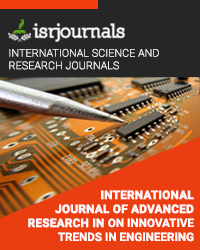design of mems single pole double throw switch based on pzt
Arko Mukherjee,Abhijeet Pasumarthy,Aminul Islam
Published in International Journal of Advanced Research in Electrical and Electronics Engineering
ISSN: 2321-4775 Impact Factor:1.6 Volume:3 Issue:2 Year: 14 February,2016 Pages:84-87

Abstract
With technological advancement in modern era, sizes of various tools used in various engineering applications has become smaller and smaller. Especially, the field of micro- engineering has gained a tremendous impetus. Working at micro-level has been a challenging job in the field of engineering for quite some time. This paper proposes the design of a 3-dimensional microelectromechanical system (3-D MEMS) model of a inverse piezo- electrically actuated single pole- double throw switch. Inverse Piezoelectric actuation has the advantage of fast response and reasonable power consumption. This paper also focuses on the optimization of the structure which will yield the best possible switching displacement (more displacement) for a particular voltage applied to the piezo – material. We have used Finite Element Method (FEM) of COMSOL Multiphysics version 4.4 to analyze all the structures. Various models have been tried out, each being subjected to numerous dimensional, structural and material variations, and the structure with best possible output has been put forward. All the parametric studies, which included total displacement of the piezo-material, stress developed has been carried out by linearly varying the voltage from 0-10 Volts.
Kewords
Keywords— Single Pole - Double Throw Piezo - Switch (SPDTPS), Finite Element Method (FEM), Meshing, MEMS, Piezoelectric actuation.
Reference
[1] Online reference https://www.mems-exchange.org/MEMS. [2] W. Tjhen, T.Tamagawa, C.P. Ye, C.C Hsueh, P.Shiller, D. L. Polla, “Properties of piezoelectric thin films for micromechanical devices and systems,” Proc. IEEE Micro Electro Mechanical Systems (MEMS’91), Japan, pp.114, 1991. [3] C.T.C. Nguyen, “Communications applications of microelectrocmechanical systems,” Proc. Sensors Expo., pp.447, May 19-21, 1998. [4] G.M. Rebeiz and J.B. Muldavin: “RF MEMS switches and switch circuits”, IEEE Microwave Magazin, Vol. 2(4), p59-71, 2001. [5] J. H. Kim, L. Wang, S. M. Zurn, L. Li, Y. Yoon, D. L. Polla, “Fabrication process of PZT piezoelectric cantilever unimorphs using micromaching,” Integrated Ferroelectrics, 15, pp. 325, 1997. [6] M. Sitti, D. Campolo, J. Yan, R.S. Fearing, T. Su, D.Taylor, and T. Sands, " Development of PZT and PZN-PT based Unimorph Actuators for Micromechanical Flapping Mechanisms, " IEEE Int. Conf. Robotics and Automation, pp. 3839-3846,Seoul Korea, May21-26, 2001 [7] R.G.Polcawich, S.Trolier-McKinstry, “Piezoelectric and dielectric reliability of lead zirconate titanate thin films,” Journal Material Research, 15(11), pp. 2505-2513, 2000. [8] T. Tamagawa, D.L. Polla, “Lead Zirconate Titanate (PZT) thin films in surface micromachined sensor structures,” IEEE Int. Electron Devices Meeting, San Francisco, 1990. [9] G. Piazza, P.J. Stephanou and A. P. Pisano, “Piezoelectric Aluminum Nitride Vibrating Contour-Mode MEMS Resonators”, Journal of MicroElectroMechanical Systems, 15/6/2006, pp. 1406-1418. [10] R. G. Polcawich, D. Judy, J. S. Pulskamp, S. Trolier-McKinstry and M. Dubey,, "Advances in Piezo electrically Actuated RF Mems Switches and Phase Shifters", Microwave Symposium, IEEE/MTT-S International, pp.2083-2086, (2007) [11] D. Hyman and M. Mehregany "Contact physics of gold microncontacts for MEMS switches", IEEE transactions on components and packaging technology, 22 p. 357,1999 [12] J.G. Smits and W. Choi: “The constituent equations of piezoelectric heterogenous bimorphs”, IEEE Transactions on Ultrasonics, Ferroelectrics and Frequency Control, Vol. 38(3), p256-270, 1991.

